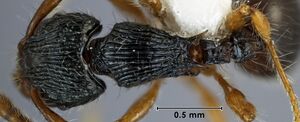Myrmecina difficulta
| Myrmecina difficulta | |
|---|---|

| |
| Scientific classification | |
| Kingdom: | Animalia |
| Phylum: | Arthropoda |
| Class: | Insecta |
| Order: | Hymenoptera |
| Family: | Formicidae |
| Subfamily: | Myrmicinae |
| Tribe: | Crematogastrini |
| Genus: | Myrmecina |
| Species: | M. difficulta |
| Binomial name | |
| Myrmecina difficulta Shattuck, 2009 | |
This rainforest and palm forest species has been collected from leaf litter and under stones.
Identification
Shattuck (2009) - Dorsal surface of mesosoma with continuous longitudinal carinae running from pronotum to propodeum; carinae extending continuously from the posterodorsal surface onto the lateral surfaces of the anterior mesosoma (the carinae extend from the mesonotum to the sides of the pronotum), the sculpturing well developed on sides of pronotum. The form of the mesosomal sculpturing combined with the smooth region behind the compound eyes will separate this species from others known from Australia.
Myrmecina difficulta shows considerable morphological variation in a number of character systems, including the size, number and shape/configuration of carinae on the head and mesosoma, the development of sculpturing in the area behind the compound eye, the length of the metanotal spines and the overall body size. In some cases these characters show as much variation as that seen between other species in the genus, strongly suggesting that multiple closely related species are involved. For example the density of carinae on the mesonotum shows considerable variation, ranging from large and widely spaced to smaller and more dense. Similarly, body size is extreme in this species, showing more variation than that found in all other species combined – a highly unexpected and surprising condition.
However, this variation was found to be largely continuous and lacking obvious subdivisions. Additionally, there are numerous examples where significant variation is seen among specimens collected from the same litter sample, suggesting that this variation is intra- rather than inter-specific.
Additionally, the variation across characters showed little correlation. For example, many of the smaller specimens show a tendency to have the carinae on the dorsum of the pronotum in the form of a “V”, a pattern also seen in some of the largest workers but absent from the majority of intermediately sized specimens (where the carinae are more or less linear).
Keys including this Species
Distribution
Latitudinal Distribution Pattern
Latitudinal Range: -16.08333015° to -22.86667061°.
| North Temperate |
North Subtropical |
Tropical | South Subtropical |
South Temperate |
- Source: AntMaps
Distribution based on Regional Taxon Lists
Australasian Region: Australia (type locality).
Distribution based on AntMaps
Distribution based on AntWeb specimens
Check data from AntWeb
Countries Occupied
| Number of countries occupied by this species based on AntWiki Regional Taxon Lists. In general, fewer countries occupied indicates a narrower range, while more countries indicates a more widespread species. |

|
Estimated Abundance
| Relative abundance based on number of AntMaps records per species (this species within the purple bar). Fewer records (to the left) indicates a less abundant/encountered species while more records (to the right) indicates more abundant/encountered species. |

|
Elevation Range
| Species | Elevation (m asl) | |||||
|---|---|---|---|---|---|---|
| 200 | 400 | 600 | 800 | 1000 | 1200 | |
| Myrmecina difficulta | 40-50 | 60-70 | 30-40 | 40-50 | ||
| Shading indicates the bands of elevation where species was recorded. Numbers are the percentage of total samples containing this species. | ||||||
Biology
Castes
 
| |
| . | |
Nomenclature
The following information is derived from Barry Bolton's Online Catalogue of the Ants of the World.
- difficulta. Myrmecina difficulta Shattuck, 2009a: 8, figs. 6, 12-16, 47 (w.) AUSTRALIA.
Type Material
- Holotype, worker, Summit, Mt. Bellenden-Ker, Queensland, Australia, Taylor,R.W. & Feehan,J., ANIC32-047353, Australian National Insect Collection.
- Paratype, 4 workers, Summit, Mt. Bellenden-Ker, Queensland, Australia, Taylor,R.W. & Feehan,J., ANIC32-047507, Australian National Insect Collection.
- Paratype, 2 workers, Summit, Mt. Bellenden-Ker, Queensland, Australia, Taylor,R.W. & Feehan,J., ANIC32-047507, The Natural History Museum.
- Paratype, 2 workers, Summit, Mt. Bellenden-Ker, Queensland, Australia, Taylor,R.W. & Feehan,J., ANIC32-047507, Museum of Comparative Zoology.
Unless otherwise noted the text for the remainder of this section is reported from the publication that includes the original description.
Description
Worker
Antennal scapes smooth or with low ridges. First segment of funiculus cone-shaped. Sides of head behind compound eyes smooth. Sculpturing on dorsal surface of mesosoma varying from running longitudinally and generally with the central carina (or carinae) running nearly the length (the pronotum not differentiated from the mesonotum) to weakly “V”-shaped anteriorly. Carinae extending continuously from the dorsal surface onto the lateral surfaces of the mesosoma. Metanotal spines very short and broadly anglular. Propodeal spines long. Erect hairs abundant, straight. Colour dark brown-black, gaster slightly lighter, antennae, mandibles, legs and tip of gaster yellow.
(n = 24)— CI 93–107; HL 0.59–0.92; HW 0.54–0.91; MTL 0.28–0.49; SI 79–97; SL 0.45–0.82; WL 0.67–1.15.
References
- Burwell, C.J., Nakamura, A. 2020. Rainforest ants (Hymenoptera: Formicidae) along an elevational gradient at Eungella in the Clarke Range, Central Queensland coast, Australia. Proceedings of the Royal Society of Queensland 125: 43-63.
- Shattuck, S.O. 2009a. A revision of the Australian species of the ant genus Myrmecina. Zootaxa 2146: 1-21 (doi:10.11646/zootaxa.2146.1.1).
References based on Global Ant Biodiversity Informatics
- CSIRO Collection
- Shattuck S. O. 2009. A revision the Australian species of the ant genus Myrmecina (Hymenoptera: Formicidae). Zootaxa 2146: 1-21.

